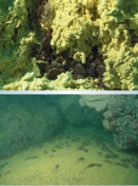A fallout feast for crabs
Crabs can take advantage of hot, toxic plumes from undersea vents to feed on poisoned plankton.
By Emily Sohn
Many people dream of living by the sea. There, they could relax or nod off to the soothing sounds of waves sweeping into shore. Some crabs endure tougher surroundings. In shallow waters off the coast of an island in Taiwan, the small crustaceans flock to vents that spew a toxic soup.
Now, researchers say they’ve found an explanation for this mysterious behavior. The hearty crabs are tapping in to a surprisingly rich food source.
 |
|
Near Kueishan Island off Taiwan, sulfur particles from undersea vents float on the sea surface, seen as a whitish scum.
|
| Dr. Jeng Ming-Shiou |
Scientists have given lots of attention to hydrothermal vents, which spit out sulfur and other toxic chemicals from beneath the ocean. Lots of strange creatures grow around these vents, including tubeworms, clams, and blind crabs. Such environments may also hold the secret to the origins of life on earth.
It turns out that vents can occur in shallow waters, too. Just a few years ago, scientists started studying shallow vents off Kueishan Island, in northeastern Taiwan, that are only 8 to 20 meters deep.
It’s possible to scuba dive to such shallow depths, but the vents are very dangerous. The water that comes out of them is extremely hot, and they spit out sulfur, which is toxic.
During a dive, a researcher from Academia Sinica in Taipei discovered that, at certain times, thousands of brown crabs came out of hiding and swarmed around the vents. When he told his coworkers about what he had seen, they wondered how there could be enough food for so many crabs.
 |
|
Top: Large groups of crabs live in the crevices of rubble at the base of a hydrothermal vent. Bottom: When the water is calm, the crabs swarm out to feed on dead plankton that had been killed by toxic gases and sulfur particles billowing out of the vent.
|
| Dr. Jeng Ming-Shiou |
The researchers noticed that the crabs swarmed at certain points in the cycle of tides and currents. A these times, the water was relatively calm, and the toxic soup spewing out of a vent rose straight up in the water. At other times of the day, the currents pushed this toxic plume sideways.
To explain the phenomenon, the scientists propose that the plumes kill lots of tiny creatures, called plankton, in the water above. Crabs can then come out to feast on the carnage.
During some dives, the diver even observed a “snow” of small fish and other creatures after plume explosions.
If you’re like me, you still might prefer the beach to a crevice near a toxic plume for your fantasy home. If you were a little crab, though, the plume might sound like a fabulous place to live—and feast.







